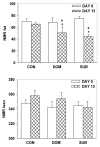Dynamic body weight and body composition changes in response to subordination stress
- PMID: 17512562
- PMCID: PMC1986729
- DOI: 10.1016/j.physbeh.2007.04.004
Dynamic body weight and body composition changes in response to subordination stress
Abstract
Social stress is prevalent in many facets of modern society. Epidemiological data suggest that stress is linked to the development of overweight, obesity and metabolic disease. Although there are strong associations between the incidence of obesity with stress and elevated levels of hormones such as cortisol, there are limited animal models to allow investigation of the etiology of increased adiposity resulting from exposure to stress. Perhaps more importantly, an animal model that mirrors the consequences of stress in humans will provide a vehicle to develop rational clinical therapy to treat or prevent adverse outcomes from exposure to chronic social stress. In the visible burrow system (VBS) model of chronic social stress mixed gender colonies are housed for 2 week periods during which male rats of the colony quickly develop a dominance hierarchy. We found that social stress has significant effects on body weight and body composition such that subordinate rats progressively develop characteristics of obesity that occurs, in part, through neuroendocrine alterations and changes in food intake amount. Although subordinate rats are hyperphagic following social stress they do not increase their intake of sucrose solution as control and dominants do suggesting that they are anhedonic. Consumption of a high fat diet does not appear to affect development of a social hierarchy and appears to enhance the effect that chronic stress has on body composition. The visible burrow system (VBS) model of social stress may be a potential laboratory model for studying stress-associated metabolic disease, including the metabolic syndrome.
Figures





Similar articles
-
Chronic social stress in a changing dietary environment.Physiol Behav. 2006 Nov 30;89(4):536-42. doi: 10.1016/j.physbeh.2006.05.026. Epub 2006 Jul 13. Physiol Behav. 2006. PMID: 16843504 Review.
-
Social stress and recovery: implications for body weight and body composition.Am J Physiol Regul Integr Comp Physiol. 2007 Nov;293(5):R1864-74. doi: 10.1152/ajpregu.00371.2007. Epub 2007 Sep 12. Am J Physiol Regul Integr Comp Physiol. 2007. PMID: 17855491
-
A closer look at the subordinate population within the visible burrow system.Physiol Behav. 2017 Sep 1;178:110-116. doi: 10.1016/j.physbeh.2017.01.039. Epub 2017 Jan 24. Physiol Behav. 2017. PMID: 28130085 Free PMC article.
-
Metabolic and endocrine consequences of social stress in a visible burrow system.Physiol Behav. 2004 Feb;80(5):683-93. doi: 10.1016/j.physbeh.2003.12.002. Physiol Behav. 2004. PMID: 14984803
-
So as we worry we weigh: Visible burrow system stress and visceral adiposity.Physiol Behav. 2017 Sep 1;178:151-156. doi: 10.1016/j.physbeh.2017.01.019. Epub 2017 Jan 12. Physiol Behav. 2017. PMID: 28089705 Review.
Cited by
-
Phenotypic effects of dietary stress in combination with a respiratory chain bypass in mice.Physiol Rep. 2019 Aug;7(13):e14159. doi: 10.14814/phy2.14159. Physiol Rep. 2019. PMID: 31267687 Free PMC article.
-
Effect of three different forms of handling on the variation of aggression-associated parameters in individually and group-housed male C57BL/6NCrl mice.PLoS One. 2019 Apr 12;14(4):e0215367. doi: 10.1371/journal.pone.0215367. eCollection 2019. PLoS One. 2019. PMID: 30978250 Free PMC article.
-
Modeling hypohedonia following repeated social defeat: Individual vulnerability and dopaminergic involvement.Physiol Behav. 2017 Aug 1;177:99-106. doi: 10.1016/j.physbeh.2017.04.016. Epub 2017 Apr 19. Physiol Behav. 2017. PMID: 28433467 Free PMC article.
-
Manifestations of domination: Assessments of social dominance in rodents.Genes Brain Behav. 2022 Mar;21(3):e12731. doi: 10.1111/gbb.12731. Epub 2021 Apr 11. Genes Brain Behav. 2022. PMID: 33769667 Free PMC article. Review.
-
Owner and Cat-Related Risk Factors for Feline Overweight or Obesity.Front Vet Sci. 2019 Aug 19;6:266. doi: 10.3389/fvets.2019.00266. eCollection 2019. Front Vet Sci. 2019. PMID: 31482097 Free PMC article.
References
-
- Flegal KM, Carroll MD, Ogden CL, Johnson CL. Prevalence and trends in obesity among US adults, 1999-2000. Jama. 2002;288(14):1723–7. - PubMed
-
- Eckel RH, Grundy SM, Zimmet PZ. The metabolic syndrome. Lancet. 2005;365(9468):1415–28. - PubMed
-
- Manson JE, Skerrett PJ, Greenland P, VanItallie TB. The escalating pandemics of obesity and sedentary lifestyle. A call to action for clinicians. Arch Intern Med. 2004;164(3):249–58. - PubMed
-
- Wolf AM, Colditz GA. Current estimates of the economic cost of obesity in the United States. Obes Res. 1998;6(2):97–106. - PubMed
-
- Raikkonen K, Keltikangas-Jarvinen L, Adlercreutz H, Hautanen A. Psychosocial stress and the insulin resistance syndrome. Metabolism. 1996;45(12):1533–8. - PubMed
Publication types
MeSH terms
Grants and funding
LinkOut - more resources
Full Text Sources
Medical

